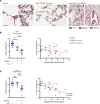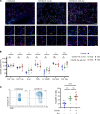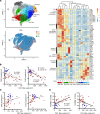Immune and epithelial determinants of age-related risk and alveolar injury in fatal COVID-19
- PMID: 35446789
- PMCID: PMC9228710
- DOI: 10.1172/jci.insight.157608
Immune and epithelial determinants of age-related risk and alveolar injury in fatal COVID-19
Abstract
Respiratory failure in COVID-19 is characterized by widespread disruption of the lung's alveolar gas exchange interface. To elucidate determinants of alveolar lung damage, we performed epithelial and immune cell profiling in lungs from 24 COVID-19 autopsies and 43 uninfected organ donors ages 18-92 years. We found marked loss of type 2 alveolar epithelial (T2AE) cells and increased perialveolar lymphocyte cytotoxicity in all fatal COVID-19 cases, even at early stages before typical patterns of acute lung injury are histologically apparent. In lungs from uninfected organ donors, there was also progressive loss of T2AE cells with increasing age, which may increase susceptibility to COVID-19-mediated lung damage in older individuals. In the fatal COVID-19 cases, macrophage infiltration differed according to the histopathological pattern of lung injury. In cases with acute lung injury, we found accumulation of CD4+ macrophages that expressed distinctly high levels of T cell activation and costimulation genes and strongly correlated with increased extent of alveolar epithelial cell depletion and CD8+ T cell cytotoxicity. Together, our results show that T2AE cell deficiency may underlie age-related COVID-19 risk and initiate alveolar dysfunction shortly after infection, and we define immune cell mediators that may contribute to alveolar injury in distinct pathological stages of fatal COVID-19.
Keywords: Aging; COVID-19; Macrophages; Pulmonary surfactants; T cells.
Conflict of interest statement
Figures







Similar articles
-
[Pathological changes of fatal coronavirus disease 2019 (COVID-19) in the lungs: report of 10 cases by postmortem needle autopsy].Zhonghua Bing Li Xue Za Zhi. 2020 Jun 8;49(6):568-575. doi: 10.3760/cma.j.cn112151-20200405-00291. Zhonghua Bing Li Xue Za Zhi. 2020. PMID: 32486534 Chinese.
-
A molecular single-cell lung atlas of lethal COVID-19.Nature. 2021 Jul;595(7865):114-119. doi: 10.1038/s41586-021-03569-1. Epub 2021 Apr 29. Nature. 2021. PMID: 33915568 Free PMC article.
-
Clinicopathologic and Immunohistochemical Findings from Autopsy of Patient with COVID-19, Japan.Emerg Infect Dis. 2020 Sep;26(9):2157-61. doi: 10.3201/eid2609.201353. Epub 2020 May 15. Emerg Infect Dis. 2020. PMID: 32412897 Free PMC article.
-
Immunohistochemical detection of sepsis-induced lung injury in human autopsy material.Leg Med (Tokyo). 2003 Jun;5(2):73-86. doi: 10.1016/s1344-6223(03)00010-5. Leg Med (Tokyo). 2003. PMID: 12935535 Review.
-
Alveolar-Capillary Membrane-Related Pulmonary Cells as a Target in Endotoxin-Induced Acute Lung Injury.Int J Mol Sci. 2019 Feb 15;20(4):831. doi: 10.3390/ijms20040831. Int J Mol Sci. 2019. PMID: 30769918 Free PMC article. Review.
Cited by
-
A narrative review on lung injury: mechanisms, biomarkers, and monitoring.Crit Care. 2024 Oct 31;28(1):352. doi: 10.1186/s13054-024-05149-x. Crit Care. 2024. PMID: 39482752 Free PMC article. Review.
-
Is Altered Surfactant Protein Gene Expression in Peripheral Blood Associated with COVID-19 Disease Severity?Diagnostics (Basel). 2025 Jul 2;15(13):1690. doi: 10.3390/diagnostics15131690. Diagnostics (Basel). 2025. PMID: 40647689 Free PMC article.
-
COVID-19 immunopathology: From acute diseases to chronic sequelae.J Med Virol. 2023 Jan;95(1):e28122. doi: 10.1002/jmv.28122. Epub 2022 Sep 13. J Med Virol. 2023. PMID: 36056655 Free PMC article. Review.
-
A Case of Interstitial Pneumonia Leading to Respiratory Failure Several Months After COVID-19 Infection.Cureus. 2025 Jan 8;17(1):e77153. doi: 10.7759/cureus.77153. eCollection 2025 Jan. Cureus. 2025. PMID: 39925489 Free PMC article.
-
Distinct Localization, Transcriptional Profiles, and Functionality in Early Life Tonsil Regulatory T Cells.J Immunol. 2024 Aug 1;213(3):306-316. doi: 10.4049/jimmunol.2300890. J Immunol. 2024. PMID: 38905110 Free PMC article.
References
-
- Epidemiology Working Group for NCIP Epidemic Response. Chinese Center for Disease Control and Prevention [The epidemiological characteristics of an outbreak of 2019 novel coronavirus diseases (COVID-19) in China] Zhonghua Liu Xing Bing Xue Za Zhi. 2020;41(2):145–151. doi: 10.3760/cma.j.issn.0254-6450.2020.02.003. - DOI - PubMed
Publication types
MeSH terms
Grants and funding
LinkOut - more resources
Full Text Sources
Medical
Molecular Biology Databases
Research Materials

